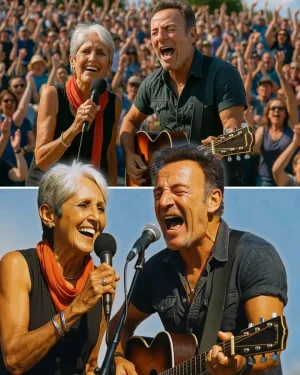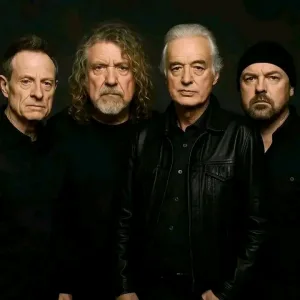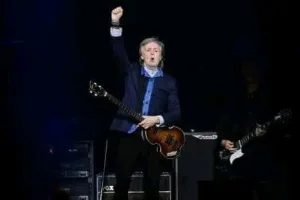On a cool summer evening that would be remembered for years to come, the air was thick with anticipation as thousands gathered under the open sky for what was billed as a legendary concert. Bruce Springsteen, the quintessential voice of working-class America, took the stage with his signature fire and fury, his guitar riffs echoing through the crowd like a rallying cry. Known for his anthems of hope, resilience, and raw honesty, Springsteen had long been a symbol of the American spirit. Tonight, however, something extraordinary happened—something that transcended music and entered the realm of collective protest.
As Springsteen launched into one of his most stirring songs, a moment of spontaneity electrified the atmosphere. From the front row, a figure rose abruptly—Joan Baez, folk legend, activist, and symbol of decades of social justice struggles. With her weathered yet fierce face, she raised her fist in the air and shouted, “We still believe in truth!” The crowd hushed for a beat, then erupted into thunderous applause and cheers. Baez’s voice, raw and unwavering, cut through the music like a knife, transforming the concert into a rally.
The scene was striking: a revered folk singer standing boldly amidst the rock and roll spectacle, making a statement that echoed beyond the music. The audience, many of whom grew up listening to Baez’s protest songs, recognized the significance of her act. It was more than just a moment of admiration; it was a declaration of resilience and conviction. The crowd roared in support, not just for Springsteen’s anthem but for Baez’s courage to speak truth to power in that charged environment.
Later, backstage, the energy of the night lingered—charged with emotion and purpose. Video footage captured a heartfelt exchange between Baez and Springsteen. In the intimate clip, Baez, her voice thick with emotion, embraced the Boss and said, “I had to be here. America’s turning into a shithole country— but your voice still gives us hope.” Her words, candid and unvarnished, reflected the despair and resolve felt by many across the nation. It was a moment of solidarity between two generations of artists who, despite their different styles, shared a common commitment to social justice and truth.
The online world exploded with reactions. Fans shared the footage across social media platforms—Twitter, Instagram, TikTok—where the moment quickly went viral. Comments poured in, praising Baez’s bravery and Springsteen’s leadership. For many, it was a reminder that music could be a powerful tool for protest and change. The image of Baez, fist raised, standing alongside Springsteen, became an emblem of resistance, inspiring countless others to speak out in their communities.
This night exemplified how music and protest can collide in a moment of pure authenticity. It reminded everyone that artists don’t just entertain—they can also challenge, inspire, and ignite movements. The synergy between Springsteen’s anthems of perseverance and Baez’s fearless call for truth created a potent blend of artistry and activism. It was a testament to the enduring power of musicians to serve as voices for the voiceless, especially in times of turmoil.
As fans left the concert that night, they carried with them a profound sense of hope and solidarity. The image of Joan Baez standing tall, fists raised, and her words echoing in their minds, became a rallying cry for many. It was a night where music transcended entertainment and became a catalyst for social consciousness.
In the days that followed, the story continued to unfold. Discussions emerged about the state of the nation, the importance of speaking truth, and the role of artists in shaping public discourse. The moment shared between Baez and Springsteen became a symbol—an emblem of resilience, defiance, and hope in a time when both are desperately needed.
In one electrifying night, a legendary concert turned into a historic act of protest. Music and activism intertwined seamlessly, reminding us all that even in the darkest times, the human spirit can shine brightly through art and courage. And as the dust settled, the image of the rebel queen standing alongside the Boss remained etched in the collective memory—a powerful reminder that truth and hope are worth fighting for.



